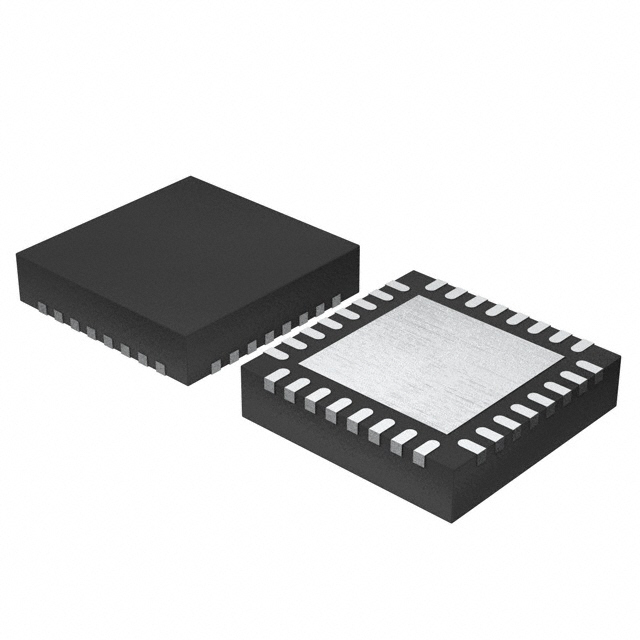ATSAMD21E15A-MU
Product Overview
- Category: Microcontroller
- Use: Embedded systems, Internet of Things (IoT) devices, and other applications requiring low-power and high-performance microcontrollers.
- Characteristics: Low power consumption, high processing speed, integrated peripherals, and advanced security features.
- Package: MU (Microchip Miniature Package)
- Essence: The ATSAMD21E15A-MU is a 32-bit ARM Cortex-M0+ microcontroller that offers a wide range of features and capabilities for various applications.
- Packaging/Quantity: Available in tape and reel packaging with a quantity of 2500 units per reel.
Specifications
- Microcontroller: ATSAMD21E15A
- Architecture: ARM Cortex-M0+
- Operating Voltage: 1.62V to 3.63V
- Clock Speed: Up to 48 MHz
- Flash Memory: 32 KB
- SRAM: 4 KB
- EEPROM: None
- Digital I/O Pins: 15
- Analog Input Pins: 6
- UART: 1
- SPI: 1
- I2C: 1
- PWM Channels: 5
- ADC Resolution: 12-bit
- Operating Temperature: -40°C to +85°C
Pin Configuration
The ATSAMD21E15A-MU microcontroller has a total of 32 pins, which are assigned to various functions such as digital I/O, analog input, communication interfaces, and power supply. The detailed pin configuration is as follows:

Functional Features
- Low Power Consumption: The ATSAMD21E15A-MU microcontroller is designed to operate at low power levels, making it suitable for battery-powered applications.
- High Processing Speed: With a clock speed of up to 48 MHz, this microcontroller can handle complex tasks efficiently.
- Integrated Peripherals: It offers various integrated peripherals such as UART, SPI, I2C, and PWM, allowing easy interfacing with other devices.
- Advanced Security Features: The ATSAMD21E15A-MU includes security features like hardware encryption and secure boot, ensuring data protection.
Advantages and Disadvantages
Advantages: - Low power consumption enables energy-efficient designs. - High processing speed allows for quick execution of tasks. - Integrated peripherals simplify system integration. - Advanced security features enhance data protection.
Disadvantages: - Limited flash memory and SRAM may restrict the complexity of applications. - Lack of EEPROM limits non-volatile storage capabilities.
Working Principles
The ATSAMD21E15A-MU microcontroller operates based on the ARM Cortex-M0+ architecture. It executes instructions stored in its flash memory, interacts with peripherals through various communication interfaces, and processes data according to the program logic. The microcontroller's clock generates timing signals for synchronization, enabling precise control over operations.
Detailed Application Field Plans
The ATSAMD21E15A-MU microcontroller finds applications in various fields, including but not limited to: 1. Internet of Things (IoT) devices 2. Home automation systems 3. Wearable devices 4. Industrial automation 5. Consumer electronics 6. Medical devices
Alternative Models
For those seeking alternatives to the ATSAMD21E15A-MU microcontroller, the following models offer similar functionality and features: 1. ATSAMD21G18A-MU 2. ATSAMD21J18A-MU 3. ATSAMD21E17A-MU 4. ATSAMD21G17A-MU
These alternative models provide a range of options with varying memory sizes, pin counts, and additional features to suit different application requirements.
Note: The content provided above is a sample structure for an encyclopedia entry and may not reflect the actual specifications or details of the ATSAMD21E15A-MU microcontroller.
Lista 10 Vanliga frågor och svar relaterade till tillämpningen av ATSAMD21E15A-MU i tekniska lösningar
Sure! Here are 10 common questions and answers related to the application of ATSAMD21E15A-MU in technical solutions:
Q: What is the ATSAMD21E15A-MU microcontroller used for? A: The ATSAMD21E15A-MU is a microcontroller commonly used in various technical solutions, such as IoT devices, wearables, industrial automation, and consumer electronics.
Q: What is the maximum clock speed of the ATSAMD21E15A-MU? A: The ATSAMD21E15A-MU operates at a maximum clock speed of 48 MHz.
Q: How much flash memory does the ATSAMD21E15A-MU have? A: The ATSAMD21E15A-MU has 32 KB of flash memory for program storage.
Q: Can I use the ATSAMD21E15A-MU for analog-to-digital conversion (ADC)? A: Yes, the ATSAMD21E15A-MU has a built-in 12-bit ADC with up to 14 channels, making it suitable for analog sensor applications.
Q: Does the ATSAMD21E15A-MU support communication protocols like UART, SPI, and I2C? A: Yes, the ATSAMD21E15A-MU supports UART, SPI, and I2C interfaces, allowing easy integration with other devices and peripherals.
Q: What is the power supply voltage range for the ATSAMD21E15A-MU? A: The ATSAMD21E15A-MU can be powered by a voltage range of 1.62V to 3.63V.
Q: Can I use the ATSAMD21E15A-MU in battery-powered applications? A: Yes, the low-power features of the ATSAMD21E15A-MU make it suitable for battery-powered applications, helping to extend battery life.
Q: Does the ATSAMD21E15A-MU have any built-in security features? A: Yes, the ATSAMD21E15A-MU includes hardware-based security features like a secure boot loader and cryptographic acceleration.
Q: Can I program the ATSAMD21E15A-MU using the Arduino IDE? A: Yes, the ATSAMD21E15A-MU is compatible with the Arduino IDE, making it easy to develop applications using the Arduino ecosystem.
Q: Are there any development boards available for the ATSAMD21E15A-MU? A: Yes, there are several development boards available, such as the Adafruit Feather M0, SparkFun SAMD21 Mini Breakout, and Arduino Zero, which use the ATSAMD21E15A-MU microcontroller.
Please note that these answers are general and may vary depending on specific implementations and requirements.


